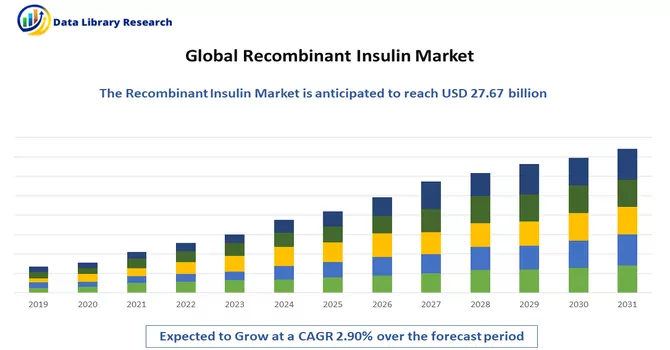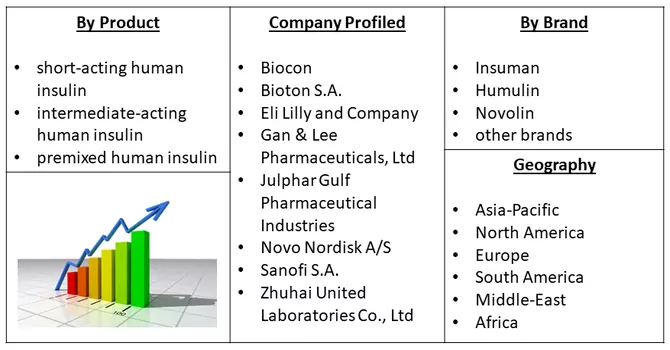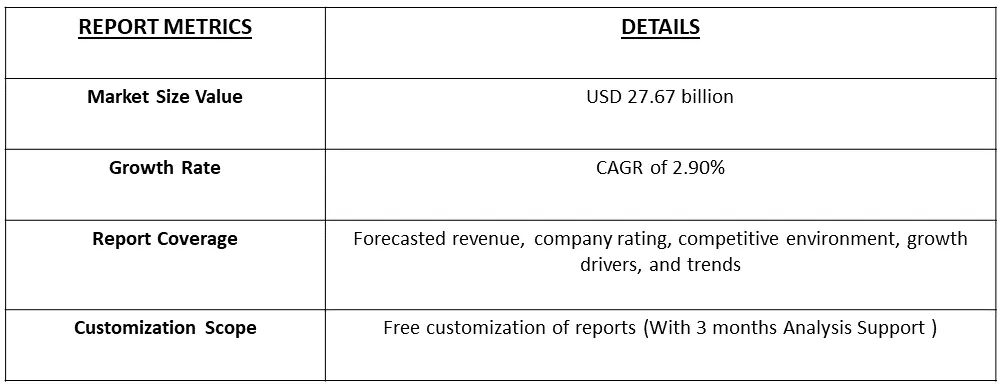The anticipated trajectory of the Global Human Recombinant Insulin Market foresees growth from its current valuation of USD 27.67 billion to reach USD 31.92 billion by the forecasted year, showcasing a Compound Annual Growth Rate (CAGR) of 2.90% during the projection period spanning from 2023 to 2030.

Get Complete Analysis Of The Report - Download Free Sample PDF
The realm of human recombinant insulin revolves around the manufacturing and dissemination of insulin created through advanced genetic engineering techniques, specifically employing recombinant DNA technology. This innovative process entails the introduction of the gene responsible for insulin production into bacteria or yeast, effectively transforming them into "factories" capable of producing insulin on a large scale. This form of insulin mirrors the composition of insulin naturally generated in the human body and is primarily employed in the treatment of diabetes.
The surge in global diabetes incidence has precipitated an escalating demand for insulin, and human recombinant insulin has emerged as the preferred standard of care for many individuals grappling with diabetes. Its efficacy and compatibility with the human body make it a cornerstone in diabetes management. The continuous evolution of biotechnology and genetic engineering has played a pivotal role in enhancing the efficiency of recombinant insulin production, rendering the manufacturing process more cost-effective and scalable.
The insulin industry is witnessing a burgeoning emphasis on personalized medicine, a paradigm that involves customizing insulin therapies based on individual patient needs. This approach, facilitated by genetic profiling and other advanced diagnostic methods, is gaining prevalence as it holds the promise of achieving improved treatment outcomes while minimizing potential side effects. The trend towards personalized medicine in insulin represents a significant stride towards tailoring diabetes management strategies to the unique characteristics and requirements of each patient.
In tandem with this transformative shift, developing regions, notably in Asia and Africa, are experiencing a notable surge in demand for insulin owing to the escalating prevalence of diabetes. This geographical expansion of the insulin market presents a dual landscape of challenges and opportunities for manufacturers. On one hand, there is the imperative to address diverse healthcare needs arising from distinct populations with varying genetic predispositions and lifestyle factors. On the other hand, this expansion offers manufacturers the opportunity to contribute to improved healthcare outcomes by providing access to insulin in regions grappling with rising diabetes rates.
Market Segmentation: The Recombinant Insulin Brands market is segmented by product type (short-acting human insulin, intermediate-acting human insulin, and premixed human insulin), brand (Insuman, Humulin, Novolin, and other brands), and geography (North America, Europe, Asia-Pacific, Middle East and Africa, and Latin America). The market provides the value (in USD million) for the above-mentioned segments.

For Detailed Market Segmentation - Download Free Sample PDF
Market Drivers:
Rising Prevalence of Diabetes
The escalating global prevalence of diabetes stands out as a pivotal catalyst driving growth within the human recombinant insulin industry. With an increasing number of individuals diagnosed with diabetes worldwide, the demand for insulin has witnessed a corresponding surge. Recombinant insulin, a pivotal component in the management of diabetes, has become increasingly indispensable due to its demonstrated effectiveness and compatibility with the human body. An illustrative example of the widespread impact of diabetes is highlighted in an article published by the NCBI in April 2021, which reported that diabetes affects a staggering 62 million individuals in the Americas. The majority of these cases are concentrated in low- and middle-income countries, and the deleterious effects of diabetes are underscored by its direct responsibility for 284,049 deaths annually. Moreover, the same source emphasizes that obesity emerges as a potent factor contributing to the risk of Type 2 diabetes, accounting for 80-85% of the overall risk for developing this form of diabetes. The linkage between lifestyle factors and diabetes is further elucidated in a subsequent update from the United States National Center for Chronic Disease Prevention and Health Promotion in April 2022. The article underscores the role of reduced physical activity as a significant contributing factor to diseases such as Type II diabetes. Thus the rising global incidence of diabetes, compounded by factors such as obesity and sedentary lifestyles, amplifies the demand for human recombinant insulin. This demand is rooted in the imperative need for effective diabetes management, positioning recombinant insulin as a critical therapeutic intervention in addressing the burgeoning healthcare challenge posed by diabetes on a global scale.
Technological Advancements in Biotechnology
Advances in biotechnology and genetic engineering have revolutionized the production of insulin. Through recombinant DNA technology, insulin can be manufactured in large quantities by inserting the insulin gene into bacteria or yeast. These technological improvements have enhanced the efficiency, scalability, and cost-effectiveness of producing human recombinant insulin, ensuring a stable and more affordable supply for those in need. Additionally, increasing product launches are also expected to drive the growth of the market during the forecast period. For instance, in January 2021, rBio, a United States-based early-stage synthetic biology company, started using rDNA technology to synthesize the production of synthetic insulin, potentially lowering the cost of insulin by 30%, as well as identify other prescription drugs that can be manufactured by manipulating microorganisms to express peptide hormones. Thus, such developments are expected to contribute towards the studied market growth over the forecast period.
Market Restraints:
Pricing Pressures and Affordability Concerns and Regulatory Hurdles and Approval Processes:
The exorbitant cost of insulin has emerged as a substantial worry, creating barriers to accessibility for certain patients, particularly in regions characterized by limited healthcare resources. The financial strain imposed by high insulin prices and concerns about affordability present challenges that may impede patient access to crucial insulin treatments. Moreover, manufacturers face obstacles in navigating stringent regulatory requirements governing the approval of new insulin products. Complying with these rigorous standards proves to be a time-consuming and expensive process, potentially leading to delays in introducing innovative insulin therapies to the market.
The forecast period anticipates a surge in the market, propelled by the impact of COVID-19. The heightened vulnerability of diabetes patients to severe outcomes during the pandemic is expected to significantly drive demand within the human recombinant insulin market. Notably, statistics from an article titled 'COVID-19 and Diabetes' published in December 2020 indicated that approximately 25% of individuals hospitalized with severe COVID-19 infections also had diabetes. Another source, 'COVID-19 and Diabetes: Understanding the Interrelationship and Risks for a Severe Course,' published in June 2021, emphasized that patients with diabetes face an elevated risk of infections, particularly respiratory tract infections such as SARS-CoV-2. Consequently, the outbreak of COVID-19 is poised to be a major catalyst fueling market growth during the pandemic period. However, the pandemic brought about a series of challenges, impacting the supply chains of pharmaceuticals, including insulin. Lockdowns, travel restrictions, and disruptions in global logistics wrought difficulties in the transportation of both raw materials and finished insulin products. This, in turn, led to temporary shortages or delays in insulin supplies in certain regions. The strain on healthcare systems, overwhelmed by the influx of COVID-19 cases, resulted in a shift in priorities. Non-COVID treatments, including insulin therapies, encountered challenges in terms of access and attention due to the overarching focus on managing the pandemic. The multifaceted impact of COVID-19 on the human recombinant insulin market underscores the intricate interplay between global health crises and the healthcare landscape, influencing both demand dynamics and supply chain intricacies.
Segmentation Analysis:
Short-acting human insulin:
Short-acting human insulin, like regular insulin, plays a crucial role in managing diabetes, especially for mealtime or correcting high blood sugar levels. Within the human recombinant insulin industry, short-acting insulin formulations have been pivotal in providing fast-acting relief for diabetic patients. These insulins are synthesized using recombinant DNA technology, where the insulin gene is inserted into bacteria or yeast to produce insulin that closely resembles the insulin naturally produced in the human body. Thus, owing to such benefits the segment is expected to witness significant growth over the forecast period.
North America Region is Expected to Witness Significant Growth Over the Forecast Period
The dominance in the human recombinant insulin market is particularly evident in the United States and Canada, where major pharmaceutical companies hold significant sway in the production and distribution of this essential medical product. These companies wield substantial market share, playing a pivotal role in influencing and shaping the trajectory of global insulin markets. Center of Research and Development Excellence: North America stands out as a primary hub for research and development activities related to insulin. The United States boasts a robust landscape of academic institutions, research centers, and pharmaceutical companies that are at the forefront of pioneering new insulin formulations, advanced delivery methods, and cutting-edge technologies for the effective management of diabetes. This concentration of research and innovation underscores North America's pivotal role in driving advancements within the insulin industry, further solidifying its position as a leader in the global healthcare landscape.
Diabetes stands out as one of the fastest-growing chronic ailments in the United States, with approximately 1.75 million Americans receiving a diabetes diagnosis annually. Notably, the country grapples with the highest obesity rates, a leading factor in the onset of type-2 diabetes. Despite these statistics, a considerable portion of the American population remains undiagnosed, with around 28% unaware of their diabetes status. Furthermore, a substantial 86% of American adults exhibit blood glucose levels that significantly elevate their risk of developing diabetes in the coming years. Over the past two decades, the incidence of diagnosed diabetes in adults has more than doubled, a trend attributed to the ageing population and the increasing prevalence of overweight or obese individuals in the United States. Thus, such incidents are expected to fuel the growth of the studied market over the forecast period.

Get Complete Analysis Of The Report - Download Free Sample PDF
The examined human recombinant insulin market displays a consolidated landscape, with a limited number of companies currently exerting dominance in the industry. This consolidation signifies the presence of key players who wield significant influence and market share within the realm of human recombinant insulin. The concentrated nature of the market implies that a select few companies play pivotal roles in shaping industry trends, innovations, and overall market dynamics. This dominance may be attributed to factors such as technological advancements, established market presence, and the ability to meet the evolving demands of healthcare and diabetes management. The consolidated nature of the market underscores the strategic importance of these key players in steering the trajectory of the human recombinant insulin market.
Some of the key market players working in this segment are:
Recent Developments:
1) April 2022: Biocon Biologics received a positive European Medicines Agency's Committee for Medicinal Products for Human Use (CHMP) opinion for Inpremzi, a biosimilar human insulin for IV infusions.
2) April 2022: Biocon Biologics in Malaysia was awarded a three-year contract, valued at USD 90 million, for its recombinant human insulin brand Insugen by the Ministry of Health, Malaysia.
Q1. What is the current Recombinant Insulin Market size?
Recombinant Insulin Market size current valuation of USD 27.67 billion.
Q2. At what CAGR is the Recombinant Insulin Market projected to grow within the forecast period?
Recombinant Insulin Market is expected to grow at a Compound Annual Growth Rate (CAGR) of 2.90% during the forecast period.
Q3. What segments are covered in the Recombinant Insulin Market Report?
By Product Type, By Brand , End-User and Geography are the segments covered in the Recombinant Insulin Market Report.
Q4. What are the factors driving the Recombinant Insulin Market?
Key factors that are driving the growth include the Rising Prevalence of Diabetes and Technological Advancements in Biotechnology.
Data Library Research are conducted by industry experts who offer insight on industry structure, market segmentations technology assessment and competitive landscape (CL), and penetration, as well as on emerging trends. Their analysis is based on primary interviews (~ 80%) and secondary research (~ 20%) as well as years of professional expertise in their respective industries. Adding to this, by analysing historical trends and current market positions, our analysts predict where the market will be headed for the next five years. Furthermore, the varying trends of segment & categories geographically presented are also studied and the estimated based on the primary & secondary research.
In this particular report from the supply side Data Library Research has conducted primary surveys (interviews) with the key level executives (VP, CEO’s, Marketing Director, Business Development Manager and SOFT) of the companies that active & prominent as well as the midsized organization
FIGURE 1: DLR RESEARH PROCESS

Extensive primary research was conducted to gain a deeper insight of the market and industry performance. The analysis is based on both primary and secondary research as well as years of professional expertise in the respective industries.
In addition to analysing current and historical trends, our analysts predict where the market is headed over the next five years.
It varies by segment for these categories geographically presented in the list of market tables. Speaking about this particular report we have conducted primary surveys (interviews) with the key level executives (VP, CEO’s, Marketing Director, Business Development Manager and many more) of the major players active in the market.
Secondary ResearchSecondary research was mainly used to collect and identify information useful for the extensive, technical, market-oriented, and Friend’s study of the Global Extra Neutral Alcohol. It was also used to obtain key information about major players, market classification and segmentation according to the industry trends, geographical markets, and developments related to the market and technology perspectives. For this study, analysts have gathered information from various credible sources, such as annual reports, sec filings, journals, white papers, SOFT presentations, and company web sites.
Market Size EstimationBoth, top-down and bottom-up approaches were used to estimate and validate the size of the Global market and to estimate the size of various other dependent submarkets in the overall Extra Neutral Alcohol. The key players in the market were identified through secondary research and their market contributions in the respective geographies were determined through primary and secondary research.
Forecast Model
